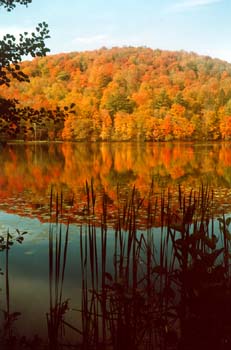

Field Trip & Course Information - Fall 2012
UPDATED May 16, 2011
James
Hayes-Bohanan, Ph.D.
I look forward to teaching this course in Fall
2012, with the same wonderful field trips.
Two
required field trips -- Dates TBA
The primary
purpose of this web page is to keep students who are enrolling in GEOG
332 informed about the required field trips, which are detailed
below and which are absolutely essential to the course. An additional
purpose is to give an overview of the course for students who may be
considering it.
The formal title of this course is
accurate but a bit of a mouthful. I prefer to describe it as a course
in land management. The course readings encompass ecology, law, and
philosophy. The course field trips put students in direct contact with
landscapes that have been managed in a variety of ways and that have
evolved in interesting ways as a result. I draw on my academic
background in physical geography and political ecology, my experience
as an environmental consultant and as a board member in a local land
trust, and my training as a certified Massachusetts Conservation
Commissioner. Guest speakers in the field and in classroom bring
expertise in forest ecology and related topics that is well beyond what
I can bring to the course directly.
The dates shown below are those that I am requested from the host facilities. I try to go when the guides I mention below are available, so some adjustment might be necessary. The ecologists I have gotten to know at each site have made incredible contributions to student learning in the past, so I work around their schedules. Please keep checking this site to see final dates, which I will confirm as soon as possible. Please contact me at jhayesboh@bridgew.edu or (508) 531-2118 if you have any questions about the trips.
Incidentally, I have a near-perfect record of picking weekends with
optimal weather and peak foliage at both sites.
 Marsh
Billings
National
Historical Park
Marsh
Billings
National
Historical Park
Tentative: A Saturday
in mid-September
Leave campus
no later than
6:30 a.m.
(You don't have to be awake,
just here!)
Return in the evening,
possibly stopping at Quechee
Gorge on the way home.
Marsh-Billings National Historical Park is the only national park to
focus on conservation history and the evolving nature of land
stewardship in America. Opened in June 1998, Vermont's first national
park preserves and interprets the historic Marsh-Billings-Rockefeller
property in Woodstock, VT. Learn
more about the property from my encyclopedia
article. Our guide is usually ranger and forest ecologist Scott
Davison, who hikes the property almost every day, even when he is not
working.
The fall 2006 semester will mark the seventh time I have taken
students to
Marsh-Billings; I went one additional time with my family, a few months
after
the park opened in 1998. I know of no better place to learn about the
history
of
different ideas of conservation in the United States. We will explore
art,
architecture, agriculture, and the biographies of three very intriguing
and
important families. We may also visit the adjacent Billings Farm and Museum,
which
is one of the earliest models of many practices for sustainable
agriculture.
We will leave between 6 and 6:30 a.m.(no later!) and return around 9
p.m.
Bring four dollars for admission, a lunch to eat on the
property, and
a few dollars for coffee on the way up and pizza, sandwiches, and/or
beverages on the
way
back.
Wear layers of clothing and sturdy shoes!
For more about the Vermont landscape, take a look at the Orton Family Foundation web site.
Tentative: A Saturday in October
Leave campus
at 7:30 a.m.
Return late afternoon
Harvard Forest is located in Petersham, Massachusetts, northwest of
Worcester and north-northeast of Quabbin Reservoir. The director of the
forest is
David
Foster, the author of one of the required texts for this course. We
are usually guided by Dr. John O'Keefe, a frequent co-author with Dr.
Foster.
Since its establishment in 1907 the Harvard Forest has served as a base for research and education in forest biology. Through the years researchers at the Forest have focused on silviculture and forest management, soils and the development of forest site concepts, the biology of temperate and tropical trees, forest ecology and economics and ecosystem dynamics.
Bring a lunch to eat on the
property, and
a few dollars for coffee on the way up and for sandwiches and/or
beverages on the
way
back.
Wear layers of clothing and sturdy shoes!